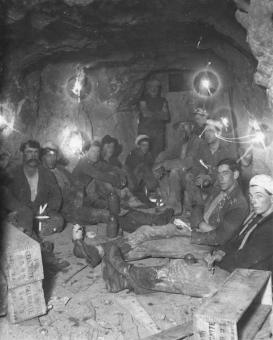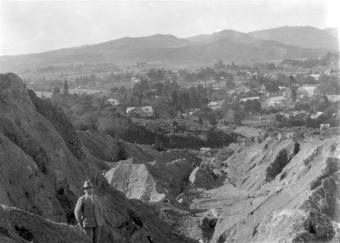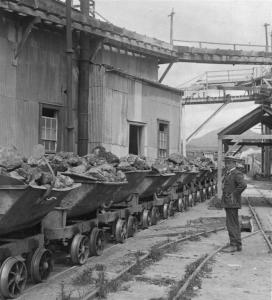
With the centennial of the 1912 Waihi
Strike upon us, this extract seems timely. It is from a letter written
by Leo Woods to Bert Roth, historian and avid creator of (now highly
valued) records pertaining to New Zealand’s labour movement. Roth may
have been collecting material for his book Trade Unions in New Zealand
(Reed, 1973), or for one of many articles and lectures he produced.
Either way, his letter to Woods and subsequent reply offers an insight
into a number of key struggles during the first decades of the twentieth
century—from the Waihi Strike of 1912, to the First World War, the One
Big Union Council and the Communist Party of New Zealand.
Woods was well placed to provide Roth with
the information he sought. Radicalised in the class struggles of 1911
and 1912, he was ‘hunted by the Police in Waihi’, active in the Auckland
branch of the Industrial Workers of the World (IWW), and during the
Great Strike of 1913 sat on the Thames strike committee. As a Wobbly and
socialist, Woods refused to fight during the First World War and was
‘thrown into one of [Prime Minister] Massey’s concentration camps,
Kiangaroa Prison Camp, near Rotorua’ for 18 months. Upon his release in
1919 he was among those who formed the One Big Union Council, becoming
literary secretary and delegated to smuggle banned literature from
Sydney until 1921, when he and other Wobblies formed the Communist Party
of New Zealand. Woods remained a member for over forty years, writing
‘Why I am A Communist’ in 1968.
Written in November 1960, the following
extract is the first four sections of what Woods titled ‘The Labour
Movement’, and is archived in the Roth Collection, MS-Papers-6164,
Alexander Turnbull Library (Wellington).
THE LABOUR MOVEMENT
Waihi Socialist Party
If my memory serves me right in the year
1910, but definitely 1911 and 1912 Waihi boasted the existence of a
Socialist Party, and together with the militant Waihi Miners’ Union
invited socialist and labour leaders near and far, who addressed massed
meetings in the Miners’ Union Hall at the weekends. The first person I
had the honour to listen to was the great socialist leader Tom Mann, who
declared he was a revolutionary socialist. Then followed Ben Tillett
and Alderman [Edward] Hartley. The strike year 1912 attracted more
speakers chief among whom were a person named [Harry] Fitzgerald, a
brilliant orator, and one Jack [John Benjamin] King, a visitor from USA
who [illegible] the principles of the IWW (Industrial Workers of the
World). He formed an economic class on Marxism and delivered several
lectures. He made a great impression on the miners. After he left NZ for
Australia, Prime Minister Massey was going to deport him. Other notable
leaders who came to Waihi were Tom Barker (IWW), H Scott Bennett, great
social reformer and member of Auckland Socialist Party, H E Holland,
Robert Semple, Paddy Webb, Peter Fraser, R F Way and others.
Waihi Strike
In may 1912 the Waihi Miners went on strike
against the action of a section of the union, some but not all of the
engine-drivers in the union breaking away from the union and forming a
‘scab’ union. These boss inspired stooges were used by the mining
companies to smash the militant class-conscious union which had won
concession after concession from the companies in round-table
conferences. Earlier the miners by ballot had discarded the Arbitration
Court as an instrument of the employing class. The mine owners feared
the growing strength of the legitimate union. The strikers fought on for
8 1/2 months, displayed a magnificent spirit of solidarity. The heroism
and pluck of the women folk in standing shoulder to shoulder with the
men was a shining example of courage and dauntless determination. In the
end the strikers were broken by the influx of Premier Bill Massey’s
police thugs who, maddened by liquor (provided by the Tory Government)
batoned the strikers [illegible] and murdered one Frederick George
Evans. Dragged him through the streets and threw him into a prison cell.
He died in hospital a victim of governmental and employers murderous
designs and cruelty, a martyr to the movement of the working class. Many
of the miners were attacked by ‘scabs’ under police protection, and
their property wrecked. Many including myself were forced to leave Waihi
because of the threat of victimisation because we would not be
re-employed. Those who did get back were forced through a searching
screening process. The union President W E Parry and a number of others
were imprisoned because they refused to sign bonds for good behaviour.
But no strike is ever lost because of the spirit of solidarity
manifested and the great boost it gives to trades unionism and the power
and strength it puts into the workers hands. During that strike the
money that was donated by the working class in NZ and Australia ran into
thousands of pounds. That was before capitalistic governments devised
the weapon of freezing union funds.
The General Strike
In 1913 a mass movement of workers staged a
general strike. Watersiders, miners, labourers, seamen, [illegible]
employees and various other trade unions fought for better conditions.
The workers gave the employers the greatest fight of their lives. In the
words of Robert (Bob) Semple Organiser of the Red Federation, that he
would stop the wheels of industry from the North Cape to the Bluff, that
is just about what took place. Labour leaders were again imprisoned.
The ‘Maoriland Worker’ official organ of the Federation of Labour and
the ‘Industrial Unionist’ official organ of the IWW group fought to the
death for the working class, whilst the capitalist press, the Auckland
‘Herald’ and ‘Star’, the ‘Dominion’ and others fought tooth and nail for
their capitalist masters. Once again the money rolled in from
Australian unions and from people who were not on strike in NZ. Strike
committees were set up in strike areas and in non-strike areas alike. In
the latter areas representatives of the strikers spoke and appealed for
funds. In one such area the Thames where a strike committee was set up
with myself as secretary, such speakers as M J Savage (afterwards
Premier of NZ), Ted Canham (Watersiders), Harry Melrose (IWW), Rob Way
and others including local speakers stated the strikers’ case. Once
again the bosses’ stooges formed scab unions. A body (13 men?) could
form a ‘scab’ union and coerce the remainder into joining it. Thus the
strike was again broken. The labour leaders turned to political action,
vote us into power they said and we will legislate for you. You will
never be jailed if you go on strike with a Labour government in power.
But under Prime Minister Peter Fraser (who at one stage led the Waihi
Strike as representative of the Red Federation of Labour) did actually
cause to be jailed ‘[illegible] workers’ who later on went on strike.
How the mighty had fallen!
The IWW
About 1912 a group known as the IWW
(Industrial Workers of the World) was formed in Auckland and other
places in NZ in the most militant areas. Huntly, West Coast of the South
Island, Wellington and elsewhere. The principles of the organization
was the advocacy of Industrial Unionism and the One Big Union. Its
headquarters were in the USA where it had a big following and had very
successful fights with the employing class there. Its preamble went like
this: ‘The working class and the employing class have nothing in
common. There can be no peace so long as hunger and want are found among
millions of working people and the few, who make up the employing
class, have all the good things of life. Between these two classes a
struggle must go on until the world’s workers organise as a class, take
possession of the earth and the machinery of production and abolish the
wages system. [illegible] ‘An Injury to one is an injury to all’.
Instead of the conservative motto ‘a fair days wage for a fair days
work’, let us inscribe upon our banner the revolutionary watchword:
abolition of the wages system.’ The IWW did not believe in parliamentary
action. The chief propagandists in the Auckland group were Tom Barker,
Charlie Reeves, Frank Hanlon (Editor of ‘Industrial Unionist’), Allan
Holmes, Jim Sullivan, Bill Murdoch, Percy Short and Jack O’Brien. Lesser
lights but still [illegible] active participation in the struggle were
Frank Johnston, George Phillips, Lila Freeman, myself, just to mention a
few. The aftermath of the 1913 strike and World War 1 scattered the
members far and wide and the group faded away.
— introduced and transcribed by Jared Davidson for Red Ruffians.




 Besides
sitting atop a gold mine, the town of Waihi rests on some political and
economic fault lines that stretch from the present right back to the
town’s European origins. Perhaps the most pivotal event in that history,
aside from the discovery of gold itself, was the miners strike which
began 100 years ago in May and ended six-and-a-half months later, after
the death on 12 November 1912 of one of the strikers, Fred Evans.
Besides
sitting atop a gold mine, the town of Waihi rests on some political and
economic fault lines that stretch from the present right back to the
town’s European origins. Perhaps the most pivotal event in that history,
aside from the discovery of gold itself, was the miners strike which
began 100 years ago in May and ended six-and-a-half months later, after
the death on 12 November 1912 of one of the strikers, Fred Evans. Challenging
the “received truth” is one of the goals of the LHP’s November seminar.
As well as a series of papers by New Zealand and Australian historians,
the LHP programme (see a draft schedule below) will be supported by a
series of cultural events, including a “Waihi oratorio” specially
written and directed by South Island playwright Paul Maunder; the launch
of “Gold Strike,” an exhibition by
Challenging
the “received truth” is one of the goals of the LHP’s November seminar.
As well as a series of papers by New Zealand and Australian historians,
the LHP programme (see a draft schedule below) will be supported by a
series of cultural events, including a “Waihi oratorio” specially
written and directed by South Island playwright Paul Maunder; the launch
of “Gold Strike,” an exhibition by  Remember Waihi – Draft Centenary Seminar Programme
Remember Waihi – Draft Centenary Seminar Programme















